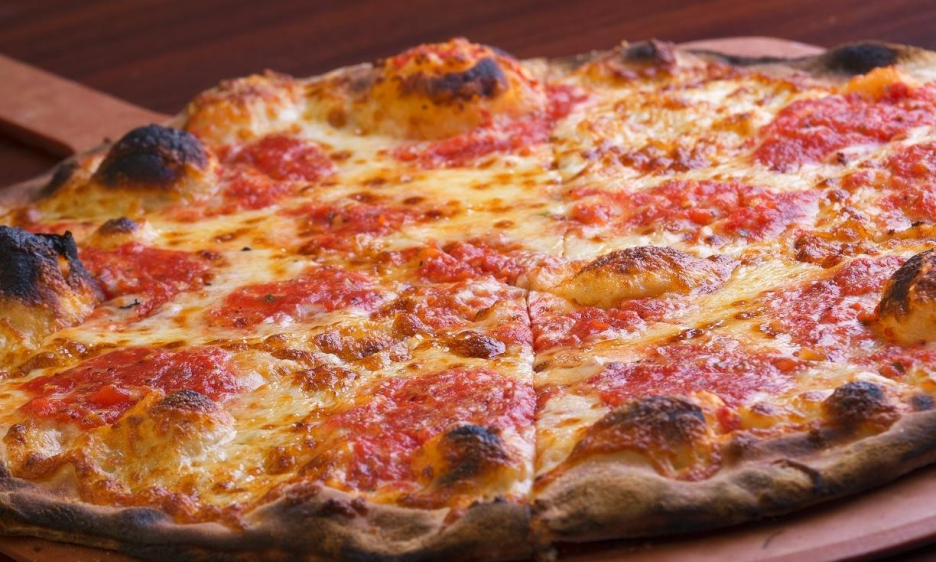Home » Jazz Articles » Genius Guide to the Good Life » American Pie
American Pie

It is said that pizza is like sex; even when it’s bad, it’s still pretty good. I would submit that pizza is superior to sex, in that it generally costs less and almost always smells better. And tipping your server is not considered an insult to one’s honor.
If you know anything about me at all, you know there are two foods I take very seriously: Barbecue and pizza. I am constantly in search of prime examples of both, and my quest has taken me from Texas to New York. My bucket list contains a mélange of eateries from BBQ joints Arthur Bryant's in Kansas City and Kreutz's in Lockhart, TX, to pizza parlors Frank Pepe's in New Haven, CT, and Lou Malnati's in Chicago. That's right. I'd rather dine at the famed Skylight Inn in Ayden, NC, or Buddy's Pizza in Detroit than swim with dolphins or climb Mt. Kilimanjaro.
Since I've already written about Barbecue, I feel I should devote some webspace to my second favorite food. Which is pizza, in case you missed the point of the first two paragraphs. Few foods are as beloved in the American culinary canon as is pizza. Its availability rivals even the ubiquitous hamburger, as both pizza chains and mom and pops permeate the landscape from sea to shining sea. Even my tiny hometown of Clifton Forge, Virginia (population 3,715, give or take a few guys I went to school with whom I've lost track of), has both a Pizza Hut and a locally-owned pizza place. But, curiously, for a place that spawned such a Barbecue-obsessed individual such as me, there are no BBQ joints currently extant in the whole of Alleghany County. There wasn't one there while I was growing up. I came to love it as a teenager, whereas I've loved pizza for as long as I can remember.
Pizza is, in many ways, nature's perfect food. Replete with soothing roundness and containing four of the five food groups (meat, bread, cheese, and whatever the hell mushrooms are), it also pairs impeccably with the fifth food group (beer). Available in one form or another in almost every corner of our great nation, it is an Italian import that has become as American as that British import, apple pie.
And speaking of pie.
The first place to serve pizza in America was Lombardi's, in New York, around 1905. The place exists even today, if the Interwebs are to be believed, and still serves the same slightly charred coal-fired oven pies on which they built their name. The first pizzas were made for Italian immigrants, a taste of home and a quick snack for their busy work days. Americans soon discovered the treat, and the rest is history. Pizza is one of my two favorite things—the other being baseball—that did not originate south of the Mason-Dixon line. Even though pizza did not originate in my beloved South, it does come from Southern Italy, so I'll let it slide.
Pizza remained primarily a Yankee treat, spreading out from the Big Apple into such enclaves as Trenton, NJ, as early as 1910 and New Haven, CT, in 1925. It wasn't until after World War II, when soldiers returning from having fought in Italy came back with a taste for their cuisine that pizza and other delicacies began spreading out from the Italian immigrant diaspora into the mainstream of American culture. Over time, Italian-American simply became American, mob movies and The Sopranos notwithstanding.
Moving forward.
Sam Sifton, New York Times food editor and former carnival roustabout, put forth the Pizza Cognition Theory. It states that the first pizza we taste on a level above the childish "I'm hungry, feed me," becomes pizza for us. The first pie we taste that we can actually appreciate for what it is becomes the ideal by which we measure all others. For me, that pizza was my mother's homemade, born out of hillbilly ingenuity in a coal camp in West Virginia in the 1950s. A dense, doughy crust topped with thick hand-cut slices of pepperoni, canned mushrooms, canned sauce, handfuls of shredded mozzarella, diced onions and green peppers. It was a treat, fixed as a snack on Saturday nights, and it was heavenly.
The first store-bought pie I tasted was from a now-defunct pizza parlor in Beckley, West Virginia, called Capri Pizza. Bathmat thick, topped with everything you could conceive of putting on a pizza (except pineapple. Don't get me started), greasier than a 1970s Ford Maverick, and completely delicious. It kind of melded with Mom's homemade to form my earliest conception of pizza as something more than just something to eat when you're hungry. To this day, I still love those ridiculously overloaded pies now referred to as 'garbage' or 'college' pizzas.
The first chain pie I had was from Pizza Hut, when they opened in the mid-Seventies in Covington, the next town over from mine. We always got the thin-crust, which I would later discover was based on the unleavened Midwestern style crust popular in the Hut's hometown of Wichita, Kansas. I still have a soft spot in my heart for Pizza Hut because they were, and are still, the only major chain to come to my old stamping grounds.
In 1978, a Sicilian immigrant named Vittorio "Victor" Cucci opened a pizza place in Covington. It was located in a veritable shanty with hardly enough room to turn around in, and he made a pie that blew my cognition theory model away. Everything about it was elementally perfect, from the crust to the sauce to the cheese. Even the pepperoni seemed better than what I'd had before. It showed me what pizza could be in a master's hands. For a ten-year-old budding gourmand, it was revelatory.
I never became a pizza snob like I am a BBQ snob. As far as Barbecue is concerned, I favor the whole-hog Eastern North Carolina style, with a thin vinegary sauce and nothing else (except maybe a little Texas Pete hot sauce). I tend to look down my nose at the Western North Carolina style BBQ, which adds ketchup to the sauce and uses only the quicker-cooking pork shoulder. But pizza, I love it all. Thin yet pliable New York style, New Haven-style white clam pie, the edible manhole cover that is Chicago deep dish, rectangular Detroit pizza with those caramelized edges, etc.
I've had innumerable imitations of the New York-style, which, like Kansas City BBQ, has become the model across the nation in places that have no regional style of their own. You won't find Trenton, NJ, tomato pie in Vinton, but you will find a joint called New York Pizza. Two guesses what they serve there. New York pizza is, itself, a burlesque impersonation of Neapolitan pie. Every chain and even most locally-owned parlors make an approximation of the Big Apple's export, even if they also offer a version of the Midwestern thin crust or the Detroit pizza. It'd be like listening to Jazz where everyone was directly influenced by Louis Armstrong; no matter how good it is, the inherent repetition would eventually become tiresome.
Fortunately, things are beginning to change, however slightly. Even in my current hometown of Roanoke, VA, I can also find Neapolitan-style brick oven pies at several places, as that style begins to take hold in places that once thought Papa John's was the be-all and end-all. There are places now that adorn pies with such exotic toppings as truffle oil and arugula that are being accepted by an increasingly metropolitan populace instead of having the purveyors burned at the stake as witches. I can find the Midwestern thin crust, cut as it is traditionally in the square Chicago box cut (also known as a 'tavern cut'). I can find an acceptable re-creation of the Detroit-style pie, sadly sans the buttery brick cheese that is one of the things that makes the Motor City's pizza unique.
Conspicuously missing, however, is the Chicago deep dish. One would think it would be a natural in the South, where we firmly believe that if some is good, more is better. And does the Chicago pie deliver more. Pan-thick and loaded with comic excesses of meat and cheese (and sometimes vegetables, for the health-conscious who actually believe that a few onions and mushrooms somehow ameliorate the caloric overkill), it's everything we in Dixie dearly love. Instead of Pizza Hut, and their pale approximation of a pan pizza, there should be Lou Malnati's or Pizzeria Uno in every town in the South with more than two gas stations and five churches.
It is said that pizza is like sex; even when it's bad, it's still pretty good. I would submit that pizza is superior to sex, in that it generally costs less and almost always smells better. And tipping your server is not considered an insult to one's honor. But it's true; even a soulless cryopie (e.g., DiGiorno, Red Baron) can still satisfy me under the right circumstances (a sadly not infrequent combination of hunger and drunkenness). My guiltiest pleasure is a mushroom and extra cheese thin crust from Little Caesar's every Friday night. Don't judge me.
Were I a more contemplative sort, I would wax rhapsodic about pizza's role in the assimilation of Italians in the American Experiment. I would talk about the proliferation and elevation of a humble Neapolitan snack into both an American staple and a conduit for our culinary ingenuity. I would toss a lot of syllables at the concept of pizza as a great equalizer; Left or Right, black or white, gay or straight, tall or short, everyone likes pizza. I once had a pie from a Korean-owned parlor in Lebanon, Tennessee. Right here in the Star City, there's a joint offering pizza and Venezuelan food. Not even the hamburger has the power to bring people together like that hot, cheesy disc o' love. When was the last time you had an office hamburger party? Pizza is an important ingredient in fulfilling the promise of E Pluribus Unum. And I'll fight the man who says different.
Till next time, kids, exit to your right and enjoy the rest of AAJ.
Tags
PREVIOUS / NEXT
Support All About Jazz
 All About Jazz has been a pillar of jazz since 1995, championing it as an art form and, more importantly, supporting the musicians who make it. Our enduring commitment has made "AAJ" one of the most culturally important websites of its kind, read by hundreds of thousands of fans, musicians and industry figures every month.
All About Jazz has been a pillar of jazz since 1995, championing it as an art form and, more importantly, supporting the musicians who make it. Our enduring commitment has made "AAJ" one of the most culturally important websites of its kind, read by hundreds of thousands of fans, musicians and industry figures every month.




















